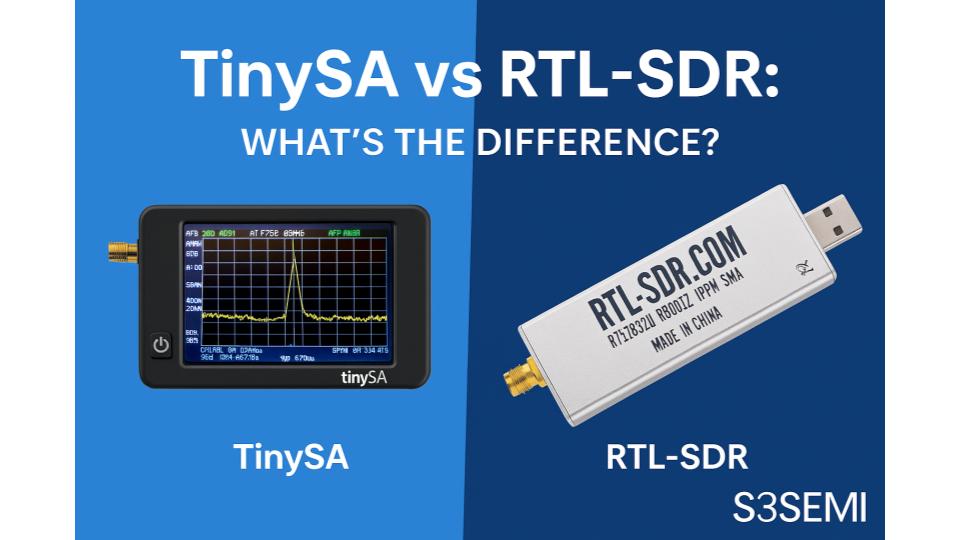When exploring low-cost RF tools, two names often appear together – TinySA and RTL-SDR. Both are compact, affordable, and incredibly useful for anyone working with radio signals, but they serve very different purposes.
Whether you’re analyzing signals, building antennas, or diagnosing interference, understanding the difference between these two devices will help you pick the right one for your setup.
⚡ Overview
- TinySA (Tiny Spectrum Analyzer) is a stand-alone spectrum analyzer with a built-in display. It scans and visualizes signal strength across frequency, much like professional analyzers used in RF labs.
- RTL-SDR (Software Defined Radio) is a USB-based receiver that turns your computer into a radio. It captures raw RF data for real-time demodulation and signal decoding through software.
In simple terms:
👉 TinySA measures RF power and spectrum activity.
👉 RTL-SDR receives and decodes actual signals.
⚙️ Specification Comparison
| Feature | TinySA | RTL-SDR |
|---|---|---|
| Function | Spectrum Analyzer | Software Defined Radio Receiver |
| Frequency Range | 100 kHz – 960 MHz (TinySA Basic) Up to 5.3 GHz (TinySA Ultra) | ~24 MHz – 1.7 GHz (varies by model) |
| Measurement Type | Power vs Frequency (spectrum view) | I/Q sampling and signal decoding |
| Dynamic Range | ~80 dB (TinySA Ultra) | ~50 – 60 dB typical |
| Signal Generator | Yes (tracking generator for filter tests) | No (receive-only, unless paired with TX hardware) |
| Display | Built-in 4.0–4.3″ touchscreen | Requires PC, tablet, or smartphone |
| Software | TinySA-App, SigDigger, GQRX | SDR#, CubicSDR, GQRX, HDSDR, SDR-Console |
| Host Requirements | Stand-alone (USB for power) | PC, Mac, or Raspberry Pi |
| Price Range (2025) | USD $60 – $150 | USD $30 – $130 |
| Best For | Spectrum scanning, filter and interference analysis | Listening, decoding, and monitoring signals |
| Power Supply | USB-C or micro-USB | USB 2.0/3.0 power from host device |
📡 TinySA: The Portable Spectrum Analyzer
The TinySA is designed for signal visualization and testing. It shows the strength of signals across frequencies – perfect for identifying interference, testing transmitters, and characterizing filters.
- ✅ Built-in tracking generator for measuring filter or amplifier response.
- ✅ Portable and battery-powered, making it ideal for fieldwork.
- ✅ Doesn’t need a computer – works stand-alone.
- ⚠️ It does not decode signals (you can’t listen to FM or view digital data).
TinySA gives you a picture of what’s happening in the spectrum, making it ideal for debugging and measuring signal environments.
🛰️ RTL-SDR: The Versatile Software Radio
The RTL-SDR dongle started as a TV tuner but evolved into one of the most versatile RF tools ever. Plug it into your computer, and you can receive signals from FM radio, aircraft (ADS-B), satellites, ham radio, and even weather balloons.
- ✅ Can decode digital modes (FT8, APRS, AIS, etc.).
- ✅ Works with powerful free software (SDR#, GQRX, SDR++).
- ✅ Incredibly wide community and project support.
- ⚠️ Needs a computer and can’t measure absolute power accurately.
RTL-SDR is essentially a universal radio receiver, while TinySA is a measurement instrument.
🧠 Practical Use Cases
| Application | TinySA | RTL-SDR |
|---|---|---|
| Checking transmitter output power | ✅ | ⚠️ Approximate only |
| Spectrum analysis and interference hunting | ✅ | ✅ (via software, less accurate) |
| FM/AM listening | ❌ | ✅ |
| Decoding digital signals (ADS-B, AIS, APRS) | ❌ | ✅ |
| Testing filters and amplifiers | ✅ (with tracking generator) | ❌ |
| Portable, stand-alone operation | ✅ | ❌ |
| Signal recording or demodulation | ❌ | ✅ |
🔧 Ideal Combination
Many RF hobbyists and engineers actually use both devices together.
- Use TinySA to measure what’s in the air and to characterize your circuits.
- Use RTL-SDR to dig deeper into what those signals contain.
Together, they form a low-cost, highly capable RF test setup that can rival gear costing hundreds or even thousands of dollars.
🧭 Final Thoughts
Both TinySA and RTL-SDR are outstanding tools — they just serve different purposes:
- TinySA is a measurement tool — precise, self-contained, and great for RF power and spectrum visualization.
- RTL-SDR is a receiver and decoder — perfect for listening, analyzing, and experimenting with real-world signals.
If you’re serious about learning RF, signal analysis, or antenna design, having both is a game-changer. The TinySA helps you see the spectrum; the RTL-SDR helps you understand it.
